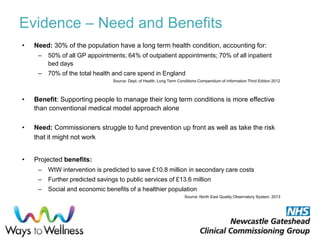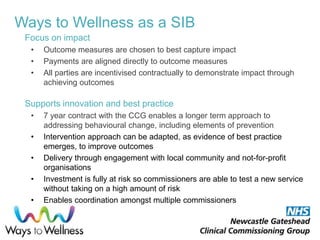CBO health event: Learning from a Live SIB: Ways to Wellness SIB
- 1. A new approach to long term conditions in the west of Newcastle Tara Case Chief Executive Ways to Wellness Philippa Dodds Delivery Project Lead Newcastle Gateshead CCG Mila Lukic Investment Manager Bridges Ventures
- 2. Provides help to people with long-term health conditions who live in the west of Newcastle upon Tyne Non-medical ‘link workers’ help them to have better quality of lives and, as a result, to reduce the cost of their care to the NHS Ways to Wellness – an introduction
- 3. Evidence – Need and Benefits • Need: 30% of the population have a long term health condition, accounting for: – 50% of all GP appointments; 64% of outpatient appointments; 70% of all inpatient bed days – 70% of the total health and care spend in England Source: Dept. of Health, Long Term Conditions Compendium of Information Third Edition 2012 • Benefit: Supporting people to manage their long term conditions is more effective than conventional medical model approach alone • Need: Commissioners struggle to fund prevention up front as well as take the risk that it might not work • Projected benefits: – WtW intervention is predicted to save £10.8 million in secondary care costs – Further predicted savings to public services of £13.6 million – Social and economic benefits of a healthier population Source: North East Quality Observatory System, 2013
- 4. What makes Ways to Wellness Unique? • The first Social Impact bond (SIB) funding behind a health service in the UK (funding from Bridges specialist SIB fund) • Social prescribing is the use of non-medical interventions to achieve sustained healthy behaviour change and improved self- care • Social prescribing at scale: – Length of contract – 7 years – Numbers of clients – over 11,000 – Link Worker works 1:1 with patients for an average of 18 to 21 months • Degree of integration with GP practices • 4 providers – varied expertise and collaborative approach
- 5. The Ways to Wellness Link Worker role— supporting patients to achieve their goals
- 6. Ways to Wellness as a SIB Focus on impact • Outcome measures are chosen to best capture impact • Payments are aligned directly to outcome measures • All parties are incentivised contractually to demonstrate impact through achieving outcomes Supports innovation and best practice • 7 year contract with the CCG enables a longer term approach to addressing behavioural change, including elements of prevention • Intervention approach can be adapted, as evidence of best practice emerges, to improve outcomes • Delivery through engagement with local community and not-for-profit organisations • Investment is fully at risk so commissioners are able to test a new service without taking on a high amount of risk • Enables coordination amongst multiple commissioners
- 8. Outcome Measures Two outcome measures trigger payments: • Outcome A: Well-being star improvements • Outcome B: Reductions in secondary care (hospital) costs compared to a control group Well-being Star TM
- 9. Challenges and Lessons Learnt Funding and Contracting • Repayment metrics – keep as simple as possible • Simplicity of outcome measures • Alignment of incentives • Sharing of risk • Contract negotiation and legal advice significant • Careful negotiations and complex choreographing of contracts Modelling and Service Development • Clarity about operational model and evidence • Multiple provider sub-contractor model • Modelling – financial and operational – require time, resources and flexibility • Strong local team and local champions (including links with local commissioners)
- 10. Challenges and Lessons Learnt Health and NHS • Retro-fitting to the NHS commissioning processes and Information Governance policies • No new money to pay for the service but realising cashable savings in the NHS is not straightforward • Health and economic benefits are often long term in nature Operations • Management Information System – bespoke IT database to support effective measurement of outcomes and management of operational delivery and measurement • Referral targets are ambitious and require push and pull factors to generate Engagement with referrers (GP practices) • Innovation requires analysis and iteration in delivery stage too
- 11. Where are we now? 44 58 52 66 72 74 92 136 82 129 0 0 37 56 65 74 74 74 108 108 108 130 130 130 0 20 40 60 80 100 120 140 April May June July August September October November December January February March 0 20 40 60 80 100 120 140 Successful New Referrals April 2015 – January 2016 Target against Actual Successful New Referrals Target Successful New Referrals
- 12. What’s next? • Increasing levels of new patient referrals • Well-Being Star improvements for patients • Reduction in secondary care (hospital) costs • Build evidence of effectiveness of approach • Share learning and spread the model
- 13. Patient Quotes “I feel really proud of myself that I’m getting out and about more.” “I now have a totally different outlook.” “I feel so much better – happier and healthier.” “This service has resolved a lot of issues that worried me.” “It has helped to focus my mind and gave me belief that things can change.” “I do believe that knowing the Ways to Wellness team is like winning a lottery ticket in life.” “I felt my Link Worker was on the same wavelength as me and I could trust her to help me.”
- 14. Questions or Comments? Website: http://waystowellness.org.uk
- 15. Workshop: Outcome Measures Questions to consider for your context / service: 1. What are the key characteristics of your target beneficiaries? 2. What key impact(s) will your service result in for them? 3. How are you going to measure this? 4. How will you access and/or collect the data? 5. How will you connect impact(s) to commissioner savings and outcome payments? 6. How can you demonstrate that your service contributed to the measured impact (attribution)














